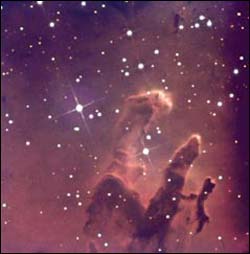UK pupils scan the skies for hazardous asteroids

M16 is a beautiful star cluster still surrounded by its embryonic gas and dust cloud. New stars are still forming in this region which lies 7,000 light years away, seen in the constellation Serpens.
Tracking newly discovered asteroids and comets to identify their orbits is the work of a small number of observatories. Yet UK students, using the Faulkes Telescope North – a remotely operated research quality telescope dedicated for educational use – will now be swelling these ranks. The students have taken such accurate data of a number of asteroids that the telescope has been awarded an observatory code and can now submit official data to the international body that monitors asteroids and comets, the International Astronomical Union’s (IAU’s) Minor Planet Centre.
The students, at King’s School in Canterbury, have been aided by their teacher Dr Andrew Taylor and Dr Lothar Kurtze, from Technische Universität in Darmstadt. Over the period of a month, several asteroids were observed to demonstrate the high quality of the images and the telescope’s ability to accurately track asteroids, an area of research called astrometry.
Dr Andrew Taylor says, “It’s great to be working alongside professional astronomers, and using the Faulkes Telescope North is extremely simple over the internet. The students are thrilled to be making a valuable contribution in this important area of research.”
In achieving the IAU code, users of the Faulkes Telescope North can now follow in the steps of Star Trek Voyager’s Seven of Nine, head of the Astrometrics Lab. She uses astrometry to plot courses for the starship to avoid hazardous areas and enemies! By using the Faulkes Telescope Project students can help provide astrometric information about the orbits of potentially hazardous asteroids and comets.
Most asteroids are discovered by a limited number of search projects which are then observed by amateur astronomers using fairly small telescopes. All new discoveries must have ‘follow-up’ observations made in order to determine accurately the asteroid’s orbit around the Sun. The follow-up observations are vital and using the new observatory code this can now be carried out by UK schools. The Faulkes Telescope Project and the Spaceguard Centre have jointly developed a programme where asteroids can be tracked, including those objects which are too small and faint to be seen with small telescopes.
Jay Tate, Director of the Spaceguard Centre says, “This is a tremendous achievement for the Faulkes Telescope Project and the students and teachers that have carried out the work. The UK can now, for the first time, make a very significant contribution to the global asteroid tracking network, and it will be schools around the country that will be doing real, cutting edge work that equals that done by professionals!”
Anyone using the Faulkes Telescope North can search for new asteroids or make follow-up observations of recent discoveries and can now get them officially recognised. This presents excellent opportunities for not only schools but also the amateur astronomy community who otherwise may not be able to access such state-of-the-art telescopes.
Currently there are only six working observatories in the UK which have this honour and none of the telescopes can compete with the size and capability of the Faulkes Telescope on the Hawaiian island of Maui which is fully robotic and has a 2m diameter primary mirror.
Media Contact
More Information:
http://www.pparc.ac.ukAll latest news from the category: Physics and Astronomy
This area deals with the fundamental laws and building blocks of nature and how they interact, the properties and the behavior of matter, and research into space and time and their structures.
innovations-report provides in-depth reports and articles on subjects such as astrophysics, laser technologies, nuclear, quantum, particle and solid-state physics, nanotechnologies, planetary research and findings (Mars, Venus) and developments related to the Hubble Telescope.
Newest articles

First-of-its-kind study uses remote sensing to monitor plastic debris in rivers and lakes
Remote sensing creates a cost-effective solution to monitoring plastic pollution. A first-of-its-kind study from researchers at the University of Minnesota Twin Cities shows how remote sensing can help monitor and…

Laser-based artificial neuron mimics nerve cell functions at lightning speed
With a processing speed a billion times faster than nature, chip-based laser neuron could help advance AI tasks such as pattern recognition and sequence prediction. Researchers have developed a laser-based…

Optimising the processing of plastic waste
Just one look in the yellow bin reveals a colourful jumble of different types of plastic. However, the purer and more uniform plastic waste is, the easier it is to…


